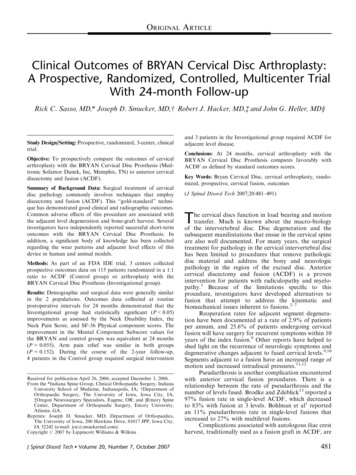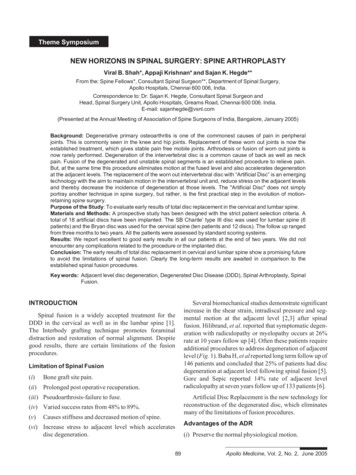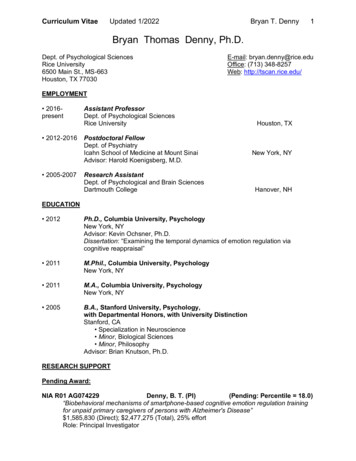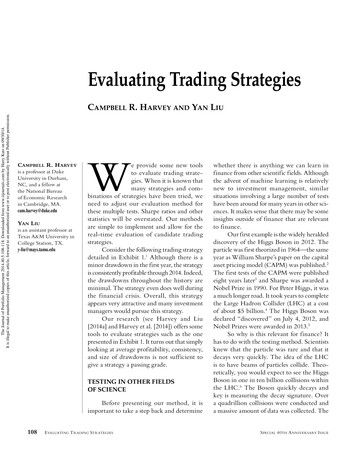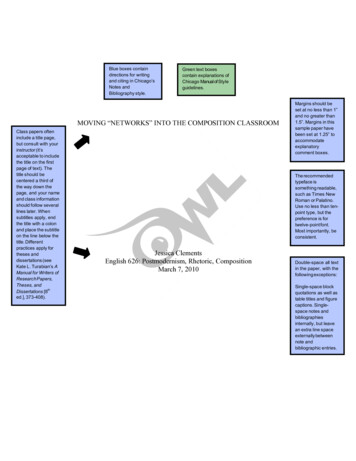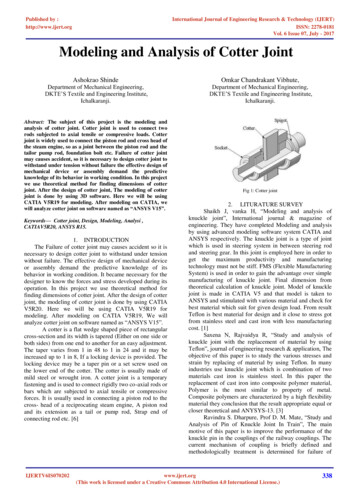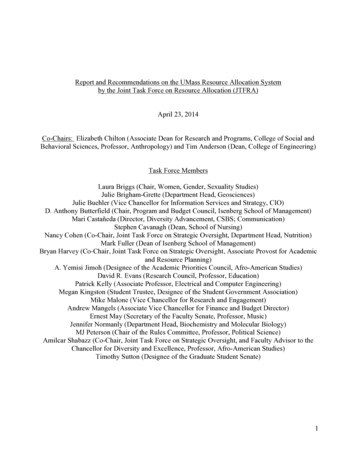
Transcription
Report and Recommendations on the UMass Resource Allocation Systemby the Joint Task Force on Resource Allocation (JTFRA)April 23, 2014Co-Chairs: Elizabeth Chilton (Associate Dean for Research and Programs, College of Social andBehavioral Sciences, Professor, Anthropology) and Tim Anderson (Dean, College of Engineering)Task Force MembersLaura Briggs (Chair, Women, Gender, Sexuality Studies)Julie Brigham-Grette (Department Head, Geosciences)Julie Buehler (Vice Chancellor for Information Services and Strategy, CIO)D. Anthony Butterfield (Chair, Program and Budget Council, Isenberg School of Management)Mari Castañeda (Director, Diversity Advancement, CSBS; Communication)Stephen Cavanagh (Dean, School of Nursing)Nancy Cohen (Co-Chair, Joint Task Force on Strategic Oversight, Department Head, Nutrition)Mark Fuller (Dean of Isenberg School of Management)Bryan Harvey (Co-Chair, Joint Task Force on Strategic Oversight, Associate Provost for Academicand Resource Planning)A. Yemisi Jimoh (Designee of the Academic Priorities Council, Afro-American Studies)David R. Evans (Research Council, Professor, Education)Patrick Kelly (Associate Professor, Electrical and Computer Engineering)Megan Kingston (Student Trustee, Designee of the Student Government Association)Mike Malone (Vice Chancellor for Research and Engagement)Andrew Mangels (Associate Vice Chancellor for Finance and Budget Director)Ernest May (Secretary of the Faculty Senate, Professor, Music)Jennifer Normanly (Department Head, Biochemistry and Molecular Biology)MJ Peterson (Chair of the Rules Committee, Professor, Political Science)Amilcar Shabazz (Co-Chair, Joint Task Force on Strategic Oversight, and Faculty Advisor to theChancellor for Diversity and Excellence, Professor, Afro-American Studies)Timothy Sutton (Designee of the Graduate Student Senate)1
Executive SummaryThe Phase 1 report of the Joint Task Force on Strategic Oversight underscored the need topromote an “evidence-based resource allocation” and to “adopt practices that reinforce the linkbetween evidence and decisions.” The Joint Task Force on Resource Allocation (JTFRA) wascharged with organizing the campus’ consideration of alternative resource allocation models andmaking recommendations to the Chancellor for moving forward with any proposed improvements.Specific expectations laid out in the charge include: (1) educating and engaging the campuscommunity; (2) identifying key characteristics for an effective resource allocation model, and (3)proposing specific changes for consideration by the campus community (Faculty Senate DocumentNo. 14-010B).Beginning in November 2013, the JTFRA worked with the assistance of Huron Education toboth examine our current resource allocation model and explore alternatives. Using the Phase 1report of the Strategic Plan as a starting point, the JTFRA developed a set of budgeting values andsix budgeting principles. These are high-level principles that were intended to help us to assess howwell our current allocation system supports our strategic priorities, and what the attributes of anynew model should be. Some of the budgeting values that the JTFRA felt were not currently wellmet by our current resource allocation model include transparency, alignment of authority withresponsibility, flexibility, and appropriate simplicity.On the basis of this analysis, the JTFRA asked Huron Education to explore a customizedUMass Resource Allocation Model (URAM), one that is more decentralized and transparent, butthat still maintains a strong holistic view of the University and support for the common good. Werecognize that any resource allocation model considered should promote a balance among research,educational opportunity, public service, and support activities that align with the strategic plan andfocus on campus success areas including quality, student success, diversity, equity, andinclusiveness. The goal in asking Huron Education to develop a model was for it to serve as aknowledge discovery process for both the JTFRA and the campus.The JTFRA worked closely with Huron Education on the development of a baseline UMassResource Allocation Model, and beginning in January, the JTFRA made a series of presentations tocampus constituencies to receive feedback on both the process and content of the model as it wasbeing developed (e.g., the Student Government Association, Graduate Student Senate, FacultySenate, Campus Leadership Council, the Council of Deans, etc.). The major components of themodel include: (1) selection of primary units (schools, colleges, and auxiliaries) and administrative& support units, (2) mechanisms for revenue allocation to the primary units, (3) allocation of coststo primary units for central services, and (3) the creation and use of a strategic investment pool—acentral pool of resources for strategic initiatives benefits the whole university.After a consideration of the baseline UMass Resource Allocation Model—both itscomponent parts and the complete model—the JTFRA recommends: (1) The University continuethe process started by the JTFRA and further evaluate a more decentralized and transparent UMassResource Allocation Model and accompanying system; (2) that this evaluation include testing ofthis UMass Resource Allocation Model in parallel with the existing model. By the end of calendaryear 2014, the campus should take stock of what has been learned and determine appropriatesubsequent action (e.g., additional study, exploration of further variations, steps towards transitionto a different model, etc.). It is important to underscore that the JTFRA is not recommendingadoption of any specific model or any specific change to the campus budgeting system at this time.In the following report we outline the process by which we came to these recommendations, thecomponents of the UMass Resource Allocation Model, its role in the UMass Resource AllocationSystem, and a proposal for next steps.2
BackgroundThe Joint Task Force on Resource Allocation (JTFRA) emerged from the first phase of theStrategic Planning process and was established in Faculty Senate Doc. No. 14-010B on October 10,2013. The Phase 1 report of the Joint Task Force on Strategic Oversight underscored the need topromote an “evidence-based resource allocation” and to “adopt practices that reinforce the linkbetween evidence and decisions.” The Report also highlights the need to set “high standards oftransparency, rationality and fairness as we tackle difficult choices.”The JTFRA takes as a given that any resource allocation system must support and embodythe values that are articulated in Phase 1 of the strategic plan: (1) excellence, (2) leadership, (3)responsibility and stewardship, (4) social progress and social justice, (5) innovation, (6) discoveryand impact, (7) engagement, (8) diversity, equity, and inclusiveness, (9) opportunity, (10) opennessand integrity, and (11) integration and collaboration.1 Not only are these values that are articulatedin the Phase 1 Report of the Strategic Plan, but these are also values that both the JTFRA and Huronheard repeatedly through our campus engagement and in our JTFRA discussions. In this report, weindicate how changes to our resource allocation system can help support all of these values.In this report we focus primarily on resource allocation models, analytical frameworks foridentifying revenues, tracing the flow of funds to the various units on campus, and assigning costs.It is important to note that any resource allocation model is only part of a wider resource allocationsystem (RAS). This wider system also includes the decision-making processes through which theflows of funds continue to be directed in ways that serve the values of the campus and enhance theability of the units, individually and collectively, to implement their strategic initiatives andcontribute to the university’s overall mission.ChargeThe charge to the JTFRA is as follows: “The Joint Task Force on Resource Allocation(JTFRA) will organize the campus’ consideration of alternative resource allocation models, andmake recommendations to the Chancellor for moving forward with any proposed improvements thatresult from the study.” Specific expectations laid out in the charge include: (1) educating andengaging the campus community; (2) identifying key characteristics for an effective resourceallocation model, and (3) proposing specific changes for consideration by the campus community.The JTFRA was charged with developing draft recommendations and presenting them to thecampus community for consideration, which we do in this document. Following a period of campusdiscussions, recommendations will be presented to the Chancellor.2Summary RecommendationThe JTFRA’s recommendation is that the University consider developing and adopting amore decentralized and transparent resource allocation model than it now employs. As we learnedmore about our current resource allocation model, it became clear that it could be improved to bettersupport many of our strategic priorities. For example, and as discussed below, our current system isboth highly centralized and opaque, and there is not a close relationship between who makesdecisions about allocating or spending resources and who takes responsibility for those decisions.Based on discussions with the campus community it is clear that our resource allocation /files/uploads/JTFSO%20Phase%20I%20Report.pdf (p.4)http://www.umass.edu/senate/fs docs/2013-2014/731/SEN DOC NO 14-010B.pdf3
does not adequately support several of our key campus values, particularly responsibility andstewardship, innovation, integration and collaboration, and openness.The JTFRA explored a variety of resource allocation models that have been adopted byother universities over the past few decades. In fact, most universities do not employ one monolithicmodel in the way they allocate resources, and we are no different. The current model at UMassAmherst is primarily a highly centralized, incremental budget model with a few areas where unitsare provided incentives to pursue particular activities. The JTFRA quickly recognized that adopting“true RCM model,” a budgeting model that is highly decentralized, for the campus would seriouslyrestrain a holistic vision for the campus and potentially undermine support for the common good. Ahighly decentralized model (such as the “every tub on its own bottom” model employed by Harvardand others) appears likely to discourage efforts to attain some of our common core values (i.e.,integration and collaboration; social progress and social justice; diversity, equity, and inclusiveness;opportunity; and excellence across the campus as a whole). A more decentralized and transparentresource allocation model than is currently used has the potential to better support values such asinnovation, discovery and impact, engagement, and openness and integrity.Using the Phase 1 report of the Strategic Plan as a starting point, the JTFRA worked withHuron Education to develop a set of budgeting values and six budgeting principles (see HuronSupplement, p. 3). Based on these principles Huron Education created an illustrative example of acustomized resource allocation model using FY13 UMass Amherst financial data. This allowed forthe presentation of campus data to provide context to the discussion of a more decentralized budgetmodel. Neither the JTFRA nor Huron is recommending that this specific model be adopted by thecampus. Instead, we recommend that the university test a parallel budget model (described below)beginning in the summer of 2014 to further explore our understanding of the implications of such amodel and thus refine it. A semester-long comparison between the model suggested by HuronEducation and the model currently in place will allow for further refinements of the model before afinal version is considered for adoption by the campus. If a new UMass Resource AllocationSystem (URAS) is adopted there would be a period of careful refinement to ensure that it is servingthe campus as a whole and that it is supporting the campus values outlined in the Phase 1 report. Infact, we expect that any Resource Allocation System should receive regular review and updating tosupport our campus values and strategies. In this report, we define the potential UMass ResourceAllocation System (URAS) as the UMass Resource Allocation Model (URAM) working togetherwith our campus strategy (as developed in the Strategic Plan). While the JTFRA at this point isrecommending the development of a URAM, it is the results of the URAS that over time will betested and may lead to changes in the URAM (or possibly the Strategy).Overview of the JTFRA and Huron activitiesThe work of the JTFRA proceeded in the following three areas, which are reviewed below: Data collection, validation, and analysisSelection of a model to examine in more detailReview of each component of the model explored and the initial model in total.Beginning in November, the first phase of the work of the JTFRA consisted of datagathering. The goal was to understand our current funds flow and resource allocation methodology.During this phase Huron Education (John Curry, Maggie Burger, and Glenn McLaurin) met withJTFRA and also with the executive leadership team, executive financial officers, academic affairsand administrative and finance support team, academic budget managers, and the Joint Task Force4
on Strategic Oversight (Huron, p. 4). This was an iterative process where Huron gatheredinformation and then engaged with the groups and individuals listed above to refine their model ofour current funds flow—that is, how funds come into campus, how they move within the campus,and where decisions are made for spending campus resources. This led to a good understanding ofhow funds currently flow to and from academic units (schools and colleges) based on data from FY13 (Huron, p. 29). It also helped to elucidate the allocation rules for the flow of funds (Huron, p.30). The JTFRA further examined trends in current higher education with respect to resourceallocation as a means to better understand how our current budget model might be improved(Huron, pp. 15-20).Through this process, the JTFRA has taken seriously the part of the charge that refers to“educating the campus.” A larger part of our work was first educating ourselves about both trends inhigher education and the details of our very complex resource allocation system. The JTFRA cochairs made several presentations to the campus community to share each component of theJTFRA’s discussions, which included: the Student Government Association, the Graduate StudentSenate, the Faculty Senate, Open Campus Forums, the Dean’s Council, the Campus LeadershipCouncil, the Academic Priorities Council, the Program and Budget Council, and the ResearchCouncil.The co-chairs also met with some of the A&S Unit Directors and held a forum forDepartment Heads and Chairs. At each of these presentations we solicited input, and this inputsignificantly informed and impacted our discussions. Huron met one-on-one with Deans and withseveral of the unit directors, and this feedback also informed the JTFRA discussions. We invited thecampus to comment on the JTFRA’s work via a blog and through a dedicated email address. TheJTFRA website contains all of the minutes of the JTFRA meetings, the charge, membership, andother materials.3In the rest of this report we review how we came to select a model option to explore further,and the components of the model that Huron developed for our consideration.Budget Values and Guiding PrinciplesThe first task for the JTFRA was to catalog our campus values relative to budgeting andcapture these in six “guiding principles” for assessing how we allocate resources on campus (Huron,p. 3). The JTFRA first identified preliminary values on the basis of both the Strategic Plan Phase 1report and interviews with the constituents mentioned above. These were then discussed with theJTFRA members, and co-chairs Elizabeth Chilton and Tim Anderson also presented these forfeedback from the Council of Deans, the Student Government Association, the Faculty Senate, theGraduate Student Senate, and an Open Campus Forum, and the Academic Priorities Council and theProgram and Budget Council of the Faculty Senate. An email was also sent to the campuscommunity on January 21st. At that time we also set up a blog for campus community members tosubmit comments on our draft guiding principles. We also received emails from individuals withcomments on both the budgeting values and the guiding principles. As a result, the guidingprinciples were modified significantly to reflect campus input (Huron, pp. 4-14).The guiding principles address the values that should be explicitly addressed in a resourceallocation model. They are a way for us to think through how our current budget model helps us toachieve our strategic priorities and in what ways it does not. But the guiding principles do notprescribe how funds should be expended. The campus strategic plan expresses the campus prioritiesclearly, and it is these strategic priorities that will guide decisions about how to spend planning/joint-taskforce-resource-allocation5
going forward. A new resource allocation model would not change the campus priorities, nor wouldit remove the importance of decision-making.4 Instead, we hope it actually makes it clear whatdecisions are being made and provides the mechanism for funding our strategic priorities.Model OptionsOnce we had a sense of the key guiding principles that the campus considered necessary fora successful resource allocation system for the campus, we began to examine the range of modelscurrently employed by university campuses across the U.S. We also explored the trends in highereducation with respect to resource allocation (Huron, pp. 15-20) and examined each of the maintypes of resource allocation models and considered their pros and cons (Huron, p. 22).The models we explored ranged from a variety of centralized budget models (incremental,formula-based, and performance-based) to more decentralized models (incentive-based orResponsibility Center Management [RCM], and an “every tub on its own bottom” [ETOB] model).We recognized that most campuses have resource allocation models that are a hybrid of thesedifferent model attributes. At UMass we currently have, for the most part, an incremental budgetingmodel. In incremental budgeting the current budget forms a base, with increments added or takenaway each year as circumstances allow or require, leading to modest changes. Incremental budgetmodels do not easily allow for rapid changes in either revenues or costs, and decisions are madecentrally for the most part. UMass also has defined some areas where colleges are encouraged todevelop initiatives that result in new revenues, which they keep and have discretion over spending(e.g., Continuing and Professional Education revenues, out-of-state student tuition and fee growth,and net graduate tuition and fee growth). However, these are only small parts of a large andcomplex system, and there is currently little transparency in how all the revenues and costs fittogether.Two key attributes that came out of the evaluation of our guiding principles were: (1)transparency, and (2) appropriate level of decentralization. In terms of the latter, it was recognizedthat a strong degree of central control in the budget process can ensure the maintenance of thecommon good. However, too much central control can limit the degree of transparency andresponsibility at the college or academic unit level that leads to more effective decision-making.Huron guided us through a process of assessing how well our current budget model alignswith our stated guiding principles (Huron, pp. 31-33). Identifying the points of alignment ormisalignment with our guiding principles allowed us to then consider how other model optionsmight better align in important ways. The JTFRA asked Huron to help us to explore a moredecentralized, customized model in more detail (Huron, p. 22), hereafter referred to as the UMassResource Allocation Model (URAM). The key attributes that were identified for a model to explorefurther included: Better align costs with revenues and provide greater transparency in measuring boththroughout the systemMore decentralized than our current incremental system, but with enough centralized controlso as to ensure the support for campus-level prioritiesUtilizes a central pool of fund or a “strategic investment pool” to address strategic prioritiesIncorporates features that emphasize strategic needs and promote entrepreneurship.4Strong support for this position can also be found in Michigan’s “Budgeting with the UB Model” p. 2-3elaborates on the difference between a model and a system, with a system extending beyond the mechanisticelements and including the discretionary elements (http://www.provost.umich.edu/budgeting/ub model.pdf).6
Provide more transparency and formality for the basis of resource allocations on campus.As stated in the “Recommendations” section above, these are the attributes that the JTFRAfelt would best support the values expressed in the Phase 1 report of the Strategic Plan.It is important to underscore that the JTFRA did not “select” a model, especially given that acustomized model by definition is one that is tailored specifically for our campus. Instead, weworked with Huron to select attributes that when combined in a model would allow us to betterunderstand what a more decentralized and more transparent budgeting model would look like atUMass. The JTFRA took on the exploration of a UMass Resource Allocation Model as a process ofknowledge discovery, where we could examine all the components of a potential model and thenassess the implications of both the component parts and the whole model.UMass Resource Allocation Model: Key Model AttributesTo create a preliminary version of a customized resource allocation model, Huron workedwith the JTFRA on each of the key model attributes. We began with an assessment of our currentstate of funds flow and the various funds types, which currently have different allocation rulesassociated with them (Huron, p. 29). Huron suggested that for the purpose of this modeling exercisethat we model an “all funds” system in which all funds are discussed, regardless of their source oruse; ideally this will simplify and make it easier to identify costs associated with revenues (Huron,p. 34). Of course if a model such as this is implemented, the University would still need to ensurefull compliance with laws and universities policies.After agreeing to explore a model with an all-funds approach, over several meetings weworked through the other major components of the model: (1) the selection of the primary units thatwould be responsible for both revenues and costs, (2) the major types of revenues that come tocampus and how they are allocated to primary units, (3) how indirect costs (costs of centralservices) are attributed to those primary units, and (4) how we should manage the size andallocation of the strategic investment pool (Huron, pp. 23-24). We review each of these in turn.Selection of Primary and of Administrative and Support Units in the ModelThe first step in building a model was to identify the primary units. For the purpose ofbuilding this type of resource allocation model, primary units are those units that have the ability toinfluence revenue generation and are able to cover all or most of the associated costs. In modelssuch as this, these are typically the schools and colleges and the auxiliaries, as is the case for UMass(Huron, pp. 25-26).Administrative and Support Units (A&S) were also identified for the purpose of buildingthis model5. These units have limited or no ability to influence revenues and they provide servicesto the primary academic units. Information about these A&S units was taken from our University’sgeneral ledger (Huron, p. 27). In many universities there are often what are termed “hybrid units”that do influence a significant portion of their revenues, but for consistency and simplicity, weconsidered these all as A&S units in this initial model; essentially any unit that serves the universityas a whole and is considered a common good is included as an A&S unit.It is important to note that nothing in this model recommends or necessitates a change inhow A&S units are currently funded, how they function, or where they report; it does, however,indicate a changes in the reporting of revenues and expenses.5See Huron Supplement p. 74 for a glossary of terms used in this report and in their supplement.7
RevenuesThe two primary sources of revenues to our campus include (1) tuition and fees, and (2) theState Appropriation (Huron, p. 36). Based on FY13 data, Huron estimates that about 385M wouldbe allocable to the schools and colleges from gross tuition and fees including the curriculum fees,in-state and out-of-state tuition revenues (Huron, p. 40)6. The State Appropriation in FY 13 was 256.9 M (Huron, p. 50)7. JTFRA spent considerable time discussing how to model the revenueallocation for tuition & fees and the state appropriation, and each is discussed below.Tuition and Fees. Universities that have moved towards a more decentralized resourceallocation model such as the one we are exploring allocate revenues from tuition and fees based onthe instruction offered in the schools and colleges. This is most often a ratio that includes both totalinstruction (measured by student credit hours) and enrollment in the major (full-time equivalents orFTEs; Huron, p. 37). In deciding what proportion to allocate based on total amount of instructionvs. enrollment in the major, there needs to be a balance between promoting recruitment, retention,and quality in the major and supporting both our general education priorities and the holistic viewof students’ education. Most schools that have moved towards an activity-based allocation model inrecent years have allocated 70-80% of the revenues based on overall instruction and 30-20% basedon enrollment in the major (Huron, p. 38). One notable exception is Michigan, which began in 1999with 100% allocation in the major, but has slowly now moved to 50/50%. The JTFRA felt that agood starting point for the purpose of this initial model was 75% overall instruction (based onstudent credit hours) and 25% major FTE. We based this starting point on (1) looking at peerinstitutions and how it has worked out for them thus far, and (2) our own assessment of the datafrom our general ledger on what portion of our instructional costs are based on academic supportand advising vs. direct instruction (Huron, p. 39). From their analysis of the general ledger, Huronestimates that our ratio of expenses for instruction vs. academic support and advising is 16%academic support and 84% instruction. Recognizing that faculty and instructors are involved inacademic support that is not likely to be fully represented in academic support expenses, the JTFRAbelieves that a 75/25% split is a good starting point. One of the ways that we tried to assess theimpact of choosing a particular proportion of overall instruction/major FTE was to note thedifferential impact on our schools and colleges (Huron, pp. 54-55). Given that our schools andcolleges vary a great deal in both the costs and types of instruction, we will need to find anappropriate balance for our starting point in the instruction/major split. We explored the sensitivityof this split on the unit margins8 of the primary units and discovered the margin for most units wassensitive to its value.One issue we did not examine in detail is our general education instruction as a proportionof total student credit hours. Given the priority that we place on general education and itsimportance to students, the JTFRA recommends that the impact of general education instruction asa proportion of total instruction be examined further.6The allocable gross tuition includes all tuition and fees; the in-state tuition remission is deducted from theState Appropriations.7This includes the value of the state-funded fringe benefits.8“Unit margin” is all the revenues that are allocated to a primary unit minus all direct and indirect costallocations8
State Appropriation. The other major source of funding to our campus comes from the stateappropriation. Of course the use of the state appropriation should—like tuition and fees—supportthe academic mission of the University, particularly teaching and learning. However, as a ResearchUniversity, a portion of the state allocation must support the research mission of the University.While we expect faculty to engage in a wide variety of research activities on our campus, we arealso well aware that sponsored research requires an investment by the University, especially since—as in all research universities—the indirect costs (also called “overhead” or Facilities andAdministration [F&A] recovery) recovered from grants and contracts does not cover the actual costsof undertaking such research. For example, the Office of Financial and Cost Analysis at UMasscalculates that the actual indirect costs of sponsored research at UMass is 72%, meaning that forevery dollar spent on external grant or contract it costs the University an additional 0.72 to carryout that research (Huron, p. 47). While our federally negotiated rate is 59%, our actual or effectiverate (that is, the rate that we actually recover on average after waivers or indirect cost reductions) is30%. This is common at all research universities since many granting agencies limit the amount ofoverhead recovery allowed. It means that 42% of the actual costs of conducting sponsored researchare not visible in our current resource allocation model,
Stephen Cavanagh (Dean, School of Nursing) Nancy Cohen (Co-Chair, Joint Task Force on Strategic Oversight, Department Head, Nutrition) Mark Fuller (Dean of Isenberg School of Management) . Huron Education to develop a set of budgeting values and six budgeting principles (see Huron Supplement, p. 3). Based on these principles Huron Education .

